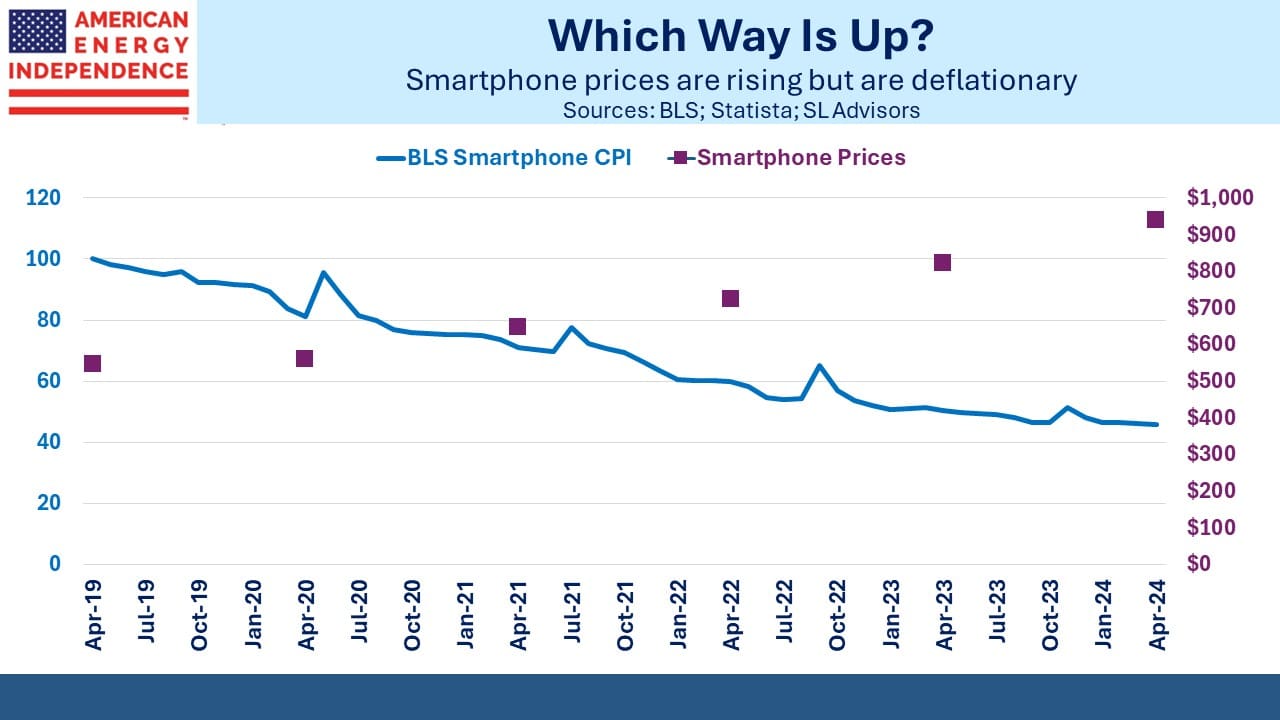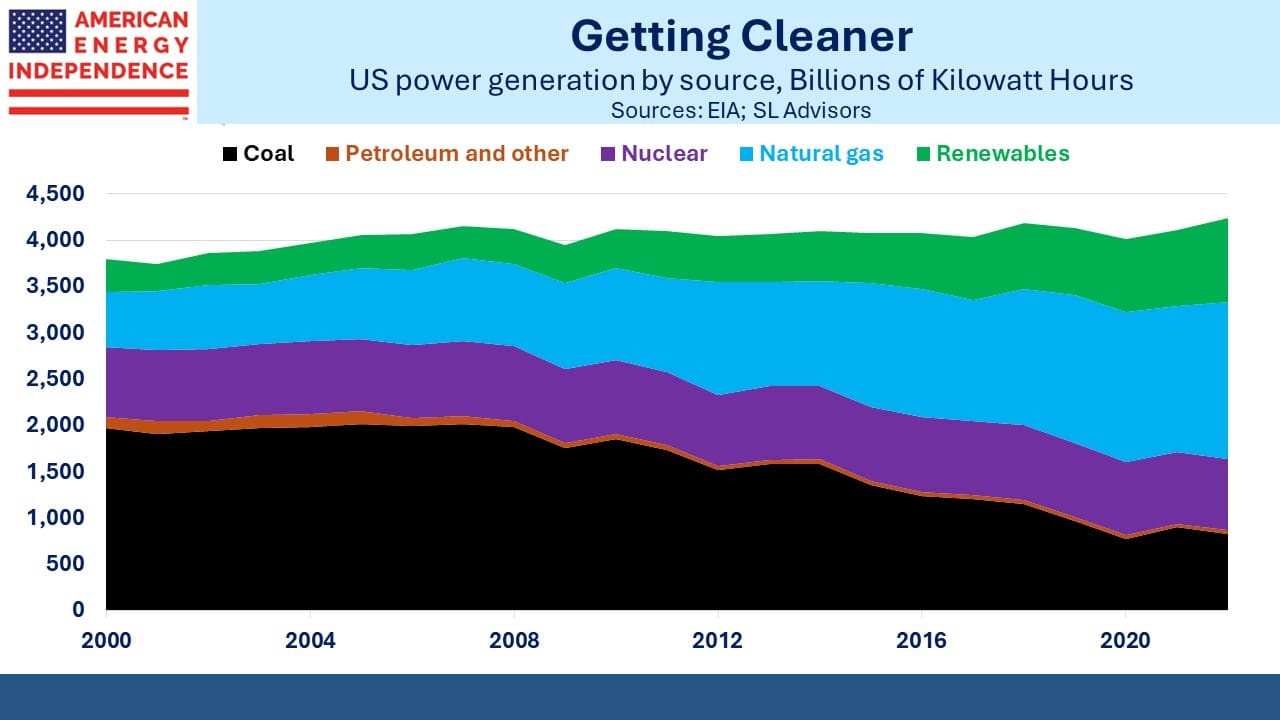The Inflationary Energy Transition

/
Ominously for President Biden, opinion polls consistently show voters are unhappy with his economic stewardship. The surge in inflation in 2022 didn’t help, but after believing it to be transitory the Fed responded and it’s now back down. Wednesday’s 3.4% CPI figure isn’t yet at the Fed’s 2% target but is close enough that the difference shouldn’t be discernible for the typical consumer.
And yet 22% of voters identify inflation/prices as their most important issue, according to a recent Brookings poll. Inflation feels higher than 3.4% to many people.
Part of the reason is that inflation calculations assume a basket of goods and services of constant utility. This anodyne term means the Bureau of Labor Statistics (BLS) adjusts for quality improvements. A better iphone gives you more utility. More iphone for the same money is a price reduction under this construct.
The chart shows the difference. Average smartphone prices are up 72% over the past five years. But adjusted for their enormous quality improvements, the BLS find that they’re down 54%. They’re called hedonic price adjustments.
This is an extreme example, but it illustrates the point. Household income isn’t up 72% over the past five years, and since it’s impossible to live without a smartphone they are commanding an increasing share of disposable income. We’re all benefitting from increased utility since today’s smartphones are better, but few of us recognize that increased utility or can figure out what to do with it.
It just means that what the BLS is measuring doesn’t correspond with how we experience the purchase of goods and services. We have written on this subject before (see Why You Shouldn’t Expect A Return To 2% Inflation, Why It’s No Longer Enough To Beat Inflation and Why You Can’t Trust Reported Inflation Numbers).
The energy transition is inflationary. It’s taken a long time for this to become clear because Democrats have long clung to the shibboleth that moving towards renewables would create well paid union jobs while exploiting the fact that solar and wind are cheaper than natural gas.
It’s now clear this was never true.
US electricity prices have moved sharply higher over the past two years, from 15.1 cents per Kilowatt Hour to 17.3 cents.
The trend over the past couple of decades has been for natural gas to displace coal, because it’s cheaper. Renewables have been gaining market share as a policy choice, often driving additional demand for natural gas to compensate for their intermittency.
Incidentally, the relative stability in annual electricity consumption of around four terawatt hours since 2000 is about to change as data centers for AI come online (see AI Boosts US Energy). This will also push natural gas demand higher over the next few years.
More weather-dependent electricity requires increased spare capacity for when it’s not sunny or windy. This reduces the capacity utilization of the grid (see Renewables: More Capacity, Less Utilization and Management Stumbles; Getting Less From Our Power Sources).
The energy transition causes inflation directly through higher electricity prices. The Inflation Reduction Act, which does the opposite of its title, is a huge source of energy subsidies. It’s intended to reduce CO2 emissions and is likely to cost over $1TN in fiscal stimulus.
Paying more for energy in order to reduce emissions isn’t necessarily a bad thing. Democrats have opted not to argue that green costs more because it’s good for you. But achieving lower CO2 underpins public policy in OECD countries to varying degrees. An economist might say that this brings greater utility. Carbon-free electricity that costs more might even cost less following a hedonic quality adjustment from the BLS.
It’s tempting to predict that the BLS will apply their statistical magic to energy prices, ameliorating price increases to reflect greater utility (ie lower emissions). A Democrat White House would surely love this, although it’s too late to make an impact before the election. But it’s unlikely, because the value of reduced emissions is unknown, and it would too easily appear politically motivated.
But it could provide a reason for the Fed to relax their 2% inflation target. There’s not much point in spending $TNs to reduce emissions if monetary policy responds by increasing the cost of capital for the long-lived assets the energy transition requires. Several years ago the Fed acknowledged an asymmetric inflation target, in that they’ll now tolerate it above 2% for a while. There’s no chance the Fed would then seek <2% inflation to bring the average lower. So we should already anticipate inflation above 2% over the long run.
This will also ease the burden of our looming fiscal catastrophe. The baby-boomer driven climb up the CBO’s steep wall of indebtedness has already begun. Tight monetary policy is making it worse via higher interest expense on outstanding debt (Our Darkening Fiscal Outlook).
Prudence dictates that investors plan for the Fed to accept inflation generally above their 2% target. All we’re waiting for is to see how they justify it.
We have three have funds that seek to profit from this environment:

Important Disclosures
The information provided is for informational purposes only and investors should determine for themselves whether a particular service, security or product is suitable for their investment needs. The information contained herein is not complete, may not be current, is subject to change, and is subject to, and qualified in its entirety by, the more complete disclosures, risk factors and other terms that are contained in the disclosure, prospectus, and offering. Certain information herein has been obtained from third party sources and, although believed to be reliable, has not been independently verified and its accuracy or completeness cannot be guaranteed. No representation is made with respect to the accuracy, completeness or timeliness of this information. Nothing provided on this site constitutes tax advice. Individuals should seek the advice of their own tax advisor for specific information regarding tax consequences of investments. Investments in securities entail risk and are not suitable for all investors. This site is not a recommendation nor an offer to sell (or solicitation of an offer to buy) securities in the United States or in any other jurisdiction.
References to indexes and benchmarks are hypothetical illustrations of aggregate returns and do not reflect the performance of any actual investment. Investors cannot invest in an index and do not reflect the deduction of the advisor’s fees or other trading expenses. There can be no assurance that current investments will be profitable. Actual realized returns will depend on, among other factors, the value of assets and market conditions at the time of disposition, any related transaction costs, and the timing of the purchase. Indexes and benchmarks may not directly correlate or only partially relate to portfolios managed by SL Advisors as they have different underlying investments and may use different strategies or have different objectives than portfolios managed by SL Advisors (e.g. The Alerian index is a group MLP securities in the oil and gas industries. Portfolios may not include the same investments that are included in the Alerian Index. The S & P Index does not directly relate to investment strategies managed by SL Advisers.)
This site may contain forward-looking statements relating to the objectives, opportunities, and the future performance of the U.S. market generally. Forward-looking statements may be identified by the use of such words as; “believe,” “expect,” “anticipate,” “should,” “planned,” “estimated,” “potential” and other similar terms. Examples of forward-looking statements include, but are not limited to, estimates with respect to financial condition, results of operations, and success or lack of success of any particular investment strategy. All are subject to various factors, including, but not limited to general and local economic conditions, changing levels of competition within certain industries and markets, changes in interest rates, changes in legislation or regulation, and other economic, competitive, governmental, regulatory and technological factors affecting a portfolio’s operations that could cause actual results to differ materially from projected results. Such statements are forward-looking in nature and involves a number of known and unknown risks, uncertainties and other factors, and accordingly, actual results may differ materially from those reflected or contemplated in such forward-looking statements. Prospective investors are cautioned not to place undue reliance on any forward-looking statements or examples. None of SL Advisors LLC or any of its affiliates or principals nor any other individual or entity assumes any obligation to update any forward-looking statements as a result of new information, subsequent events or any other circumstances. All statements made herein speak only as of the date that they were made. r
Certain hyperlinks or referenced websites on the Site, if any, are for your convenience and forward you to third parties’ websites, which generally are recognized by their top level domain name. Any descriptions of, references to, or links to other products, publications or services does not constitute an endorsement, authorization, sponsorship by or affiliation with SL Advisors LLC with respect to any linked site or its sponsor, unless expressly stated by SL Advisors LLC. Any such information, products or sites have not necessarily been reviewed by SL Advisors LLC and are provided or maintained by third parties over whom SL Advisors LLC exercise no control. SL Advisors LLC expressly disclaim any responsibility for the content, the accuracy of the information, and/or quality of products or services provided by or advertised on these third-party sites.
All investment strategies have the potential for profit or loss. Different types of investments involve varying degrees of risk, and there can be no assurance that any specific investment will be suitable or profitable for a client’s investment portfolio.
Past performance of the American Energy Independence Index is not indicative of future returns.





Well said. I agree!
Interesting and intelligent article; however, the author apparently does not buy his own gasoline, his own groceries, look at his city utility bills, look at his area power company bills, shop for new (or used) vehicles, eat at everyday fast food “bargain” restaurants, and on and on — in other words — the basket of essential goods and services that populate that basket, and drain it. What has been ripped from the lower and middle class is their ability to scrimp and save and put away money for a rainy day. Sure, a top down analysis ala Jerome Powell will satisfy an east coast elite earning $200,000 to a million per year, and s/he can read about it on the smartphone w a cell data plan, and it’s all noise level. To someone living on $50,000 or $40,000 or $30,000 per year, the initial spike in prices that more than doubled many daily consumibles and has NOT gone down, the 3.4% misses the mark. Pressure to adapt to cost of living grew astronomically and quickly, and the masses are left beaten up, and not comforted by “only 3.4%” inflation rates from here when the jump of 2021-22 smacked them up the side of the head and that is what never came down. In a few words, the analysis suffers from starting from an erroneous base of cost. That is what skewered the lower and middle classes, that jump that never came down. Adjust your thinking to people level, not statistical level.
The $3,000 per month worth of hard hit priced consumibles affects someone making $50,000 per year a lot more than the person making $100,000 per year. It is not noise level, and 3.4% means nothing when the prices initially massively jumped the basis of cost of living.